The Vimoutiers Tiger I Tank
This is one of two original WW2 German Army Tiger I tanks left out in the wild and not kept under cover in a Museum. The other is in a poor condition in roadside memorial in Russia. In France all German armored vehicles are automatically classified as the property of the French Army. This includes the Vimoutier Tiger. It is also classified as the property of the city of Vimoutier. (Pronounced Vim-moo-t-a) It has double protection. It cannot be sold. There is no engine or gear box inside.
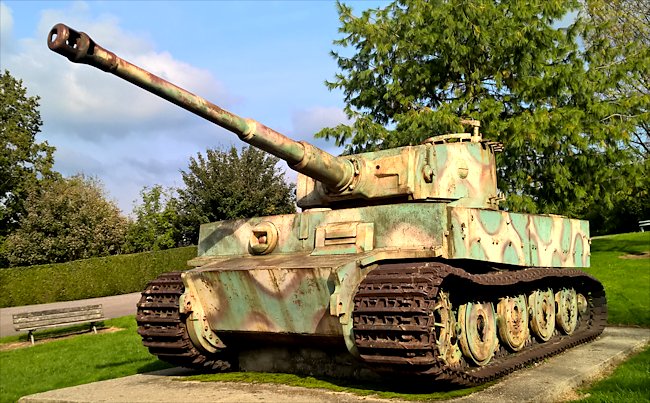
This rare surviving Battle of Normandy Tiger I tank at Vimoutiers needs restoring.
Location
The Vimoutiers Tiger Tank south east of Caen in the middle of the Normandy countryside needs a lot of restoration work. It is rusting away and its paint work needs redoing. There are lots of external and internal parts missing. The most noticeable external partsare the upper track guards and the rear twin exhausts.
Set your Sat-Nav to Vimoutiers, Avenue du Marechal Leclerc. This is the D979. When your Sat-Nav says you have arrived keep driving east out of town up hill. The Vimoutiers Tiger is about a mile outside of the town in a layby on the left on a stretch of the D979 road that does not have a name.
It is in an impressive commanding location. As you come around a bend halfway up a long hill you see the Tiger looking down on your position from near the top of the crest of the ridge. If you were an allied soldier and saw that in 1944 you would need a change of underpants.
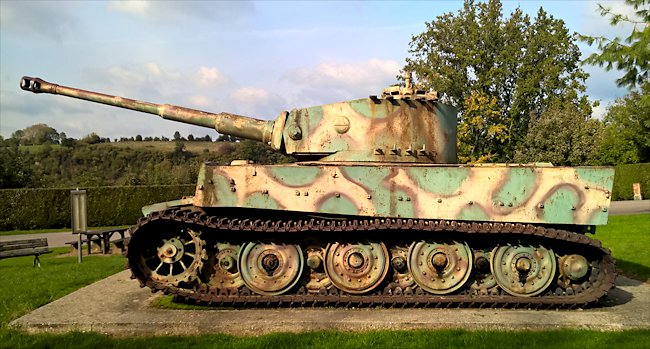
Side view of the Vimoutiers Tiger tank
Specification
The Tiger I tank PzKw VI Ausf E weighed 57 tonnes. It was powered by a Maybach HL230 P45 V-12 engine that produced 700 bhp. This gave the tank a maximum road speed of 45.4 km/h (28.2mph). It was armed with a 88mm Kwk 36 L/56 main gun and two 7.92mm MG 34 machine guns. One machine gun was fitted in a ball mount in the hull and the other coaxial next to the main gun in the turret.
It had a fuel capacity of 540 litres which gave it an operational range of between 110-195 km (68-121 miles). It had 100mm or armour protection at the front and 80mm on the side. The gun mantlet had 120mm of armour. Crews were instructed to angle the tank at 45° to enemy tanks to increase the amount of metal and enemy shell would have to penetrate. This tactic effectively increased the front armour to 180mm and the side armour to 140mm and improved the chance of shells ricocheting. It was the only way it could protect itself from the British 17pdr gun fitted to the Sherman Firefly and Archer SPG.
Tiger I Tanks in Museums
There are only six Tiger One tanks in museums. The Tank Museum in Bovington, England has a working example. The German tank Museum has a Tiger tank nicknamed the Frankentiger as it was restored using parts from many different destroyed and scrapped Tiger I tanks. There is also a Tiger tank at the French Tank Museum in Saumur, one in the Kubinka Tank Museum Russia and one in the USA at Fort Benning.
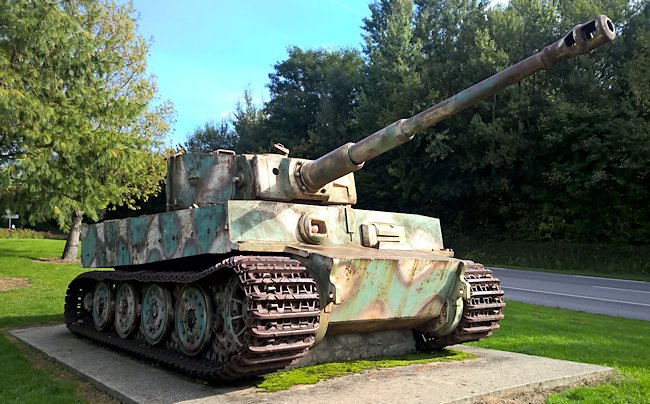
Notice that the Tiger is missing its track guards and machine guns.
History of the Vimoutiers Tiger tank
On the 19th August 1944 several German tanks from mixed units, including the Vimoutiers Tiger I, were making their way to get refuelled at the Army fuel dump set up in the Chateau de l'Horloge. They had to make a detour along the Vimoutiers-Gace road.
They were trying to escape the encirclement of the Falaise pocket. A number of the panzers ran out of fuel on that road, before they got to the Chateau and had to be abandoned. These included a Panzer III, a number of Panzer IVs, three Tiger I tanks and a King Tiger. It is believed that around 60 German tanks were abandoned around the rolling hills and rich dairy farmland that surrounds Vimoutiers during the last days of August 1944. Most were cut up after the war by scrap-metal merchants.
The Vitmoutiers Tiger ran out of fuel. Tiger tanks are very thirsty beasts and going up and down all the limestone hills did not help its fuel consumption. It ground to a halt in the middle of the road. It was too heavy to push off or tow to the road side using a smaller tank.
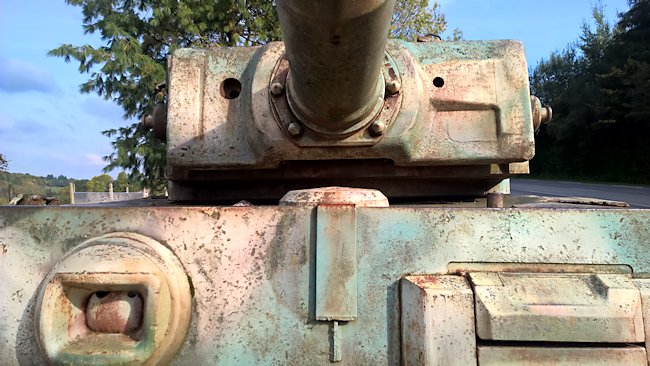
The Sherman 75mm tank gun could not penetrate the Tiger tanks front armour.
The crew placed the demolition charges they had been given on the engine cover and along the turret. The explosives caused the armoured covers on top of the engine to buckle The turret was jammed by the second explosion.
When the Americans liberated the town of Vitmoutiers the disabled Tiger tank was deemed to be causing a traffic obstruction. A US Army bulldozer was used to push it off the road to enable the essential supply lorries to reach the ever moving front.
The Saving of the Tiger
French Scrap-metal merchant M.Morat purchased the Tiger tank. He took out the transmission but left it sitting on the northern side of the road in a ditch, with its gun pointing menacingly up the road at passing vehicles.
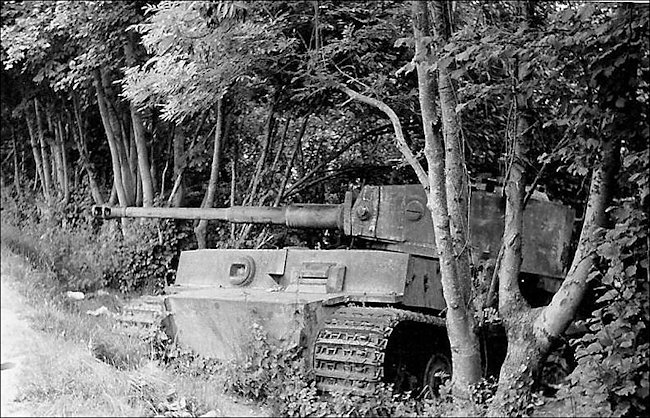
The Vimoutiers Tiger tank was bulldozed off the main road into the side of the road
For over thirty years it was left to rust and get covered in moss. Local children would play on this once deadly weapon of war. It became a local landmark.
Mr Morat's sister inherited the Tiger Tank when he died. She did not want it and sold it to a scrap-metal merchant in Caen. It was too heavy to be towed away and the company arrived on site with oxy-acetylene metal cutting tools with the intention of cutting it up piece by piece and transporting it away to a smelter in Caen.
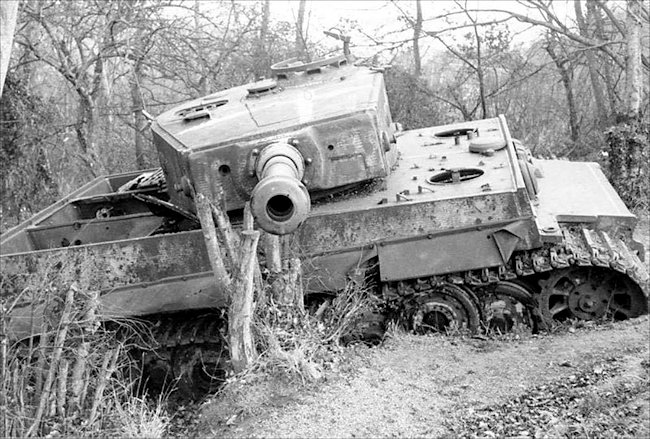
The Vimoutiers Tiger tank powerful 88mm gun. It is missing its engine covers and hatches
A local resident saw what was happening to the town's historic landmark and was horrified. He contacted the Mayor of Vimoutiers and with the help of a French Normandy D-Day historian, Eddy Florentin, an emergency purchase of the tank on behalf of the town of Vimoutiers was authorised by the Paris War Office.
In October 1975 the work of restoring the Tiger tank began with its removal from its ditch. This was not an easy job as it was so heavy. The turret was removed to lighten the load. It then took two very large powerful JCB tractor units to pull it out of its resting place for the past 30 years.
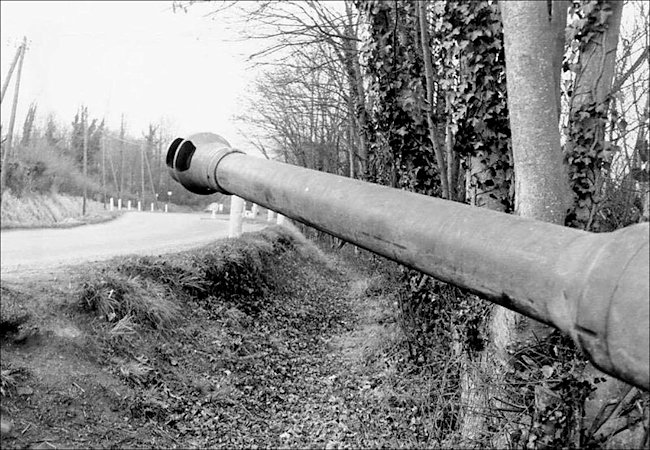
The Vimoutiers Tiger tank stayed in this location for a long time with its 88mm gun pointing menacingly up the main road.
All the hatches were welded shut. The armour plating was treated for rust and re-sprayed a desert yellow as a base colour. The turret was then refitted. The additional colours of the Tiger tank's camouflage scheme were added to match the original pattern and colours found on the tank before it was restored.
It was initially just placed in a graveled area by the side of the road near where it was found. Today it takes pride of place in a lawned lay-by, with tarmacked parking spaces on a raised plinth.
The Vimoutier local residents and council should take pride in what they have achieved but saying that it is looking a bit tired. It needs another restoration. There are many external parts missing from the tank like the track guards and classic twin rear exhausts. In my opinion the council should try and get these parts located or failing that fabricated and added to the tank so that visitors can view this beast in the same condition as it was in August 1944 when it ran out of fuel.
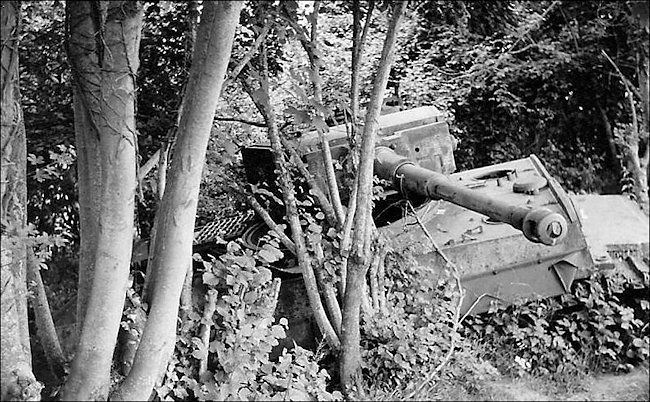
You can see that the Vimoutiers Tiger tank still had its side track guards attached when this photo was taken.
It needs to be restored
Please send a letter (not an e-mail - which can easily get deleted and ignored) to the Mayor of Vimoutier encouraging him to restore the Tiger tank and publicise its location better internationally as well as in France. The French Direction of Historical monuments has given total estimated cost of restoration of the Vimoutier Tiger as follows: Option One basic restoration (only the external body) 200,000 euros; option 2 for a total restoration including new engine and gearbox (Saumur and Munster tank museums to agree to furnish the missing parts) 1,000,000 euros to bring her back to a running condition.
The Tiger is badly damage by the rust. You can't just respray on the rust. Some parts of the armour needs to be changed. Other to be rewelded, sandblasted etc... All the drive train is destroy (torsion bars, bearings...) Some parts of the tracks are cut by the rust. The Turret has been welded with body some years ago to reinforce the structure...You will never restore it with just 20 liters of paint. It is a very, very, very big restoration. The French Tank Museum in Saumur has in stock a couple of Tiger Tank engines, gearboxes, final drives, and tracks
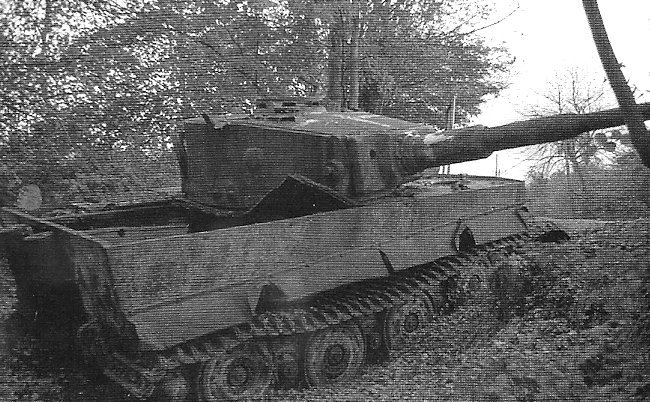
Vimoutiers Tiger is very near the village of Camembert where the famous cheese was first made.
Camembert Cheese
The Vimoutiers Tiger I tank is in the middle of Camembert Cheese Country. After you have looked at the Tiger set your Sat-Nav to the village of Camembert. Visit the Camembert Museum and see how this famous cheese is made then afterwards go to the shop on the other side of the road for free cheese tasting. For the tank enthusiasts you have to search for the Camembert Cheese label that has a Renault FT tank on the front that was stuck on Cheeses supplied to the French troops at the front in WW1.
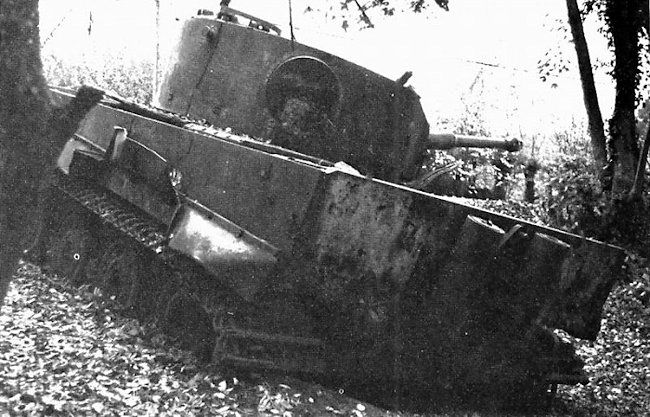
The Vimoutiers Tiger is tank in a hull down position pointing its 88mm gun up the road.
The race to Normandy
The German Army as well as Hitler believed that the main invasion would land near Calais. This belief was even held after the Allies had landed in Normandy which they considered a faint. Eventually they realised their error and orders were sent to Panzer units held in reserve near Paris to go to Normandy.
The Schwere SS-Panzer Heavy Tank Battalion Abteilung 102's Tigers were stationed in the grounds of Versailles Palace when they received their orders to advance to Normandy. Their three panzerkompanies were at full strength but the long journey by road took its toll in mechanical breakdowns.
They were deployed to Hill 112 south west of Caen and engaged in tank battles with Allied Sherman and Churchill tanks which they were normally the victor.
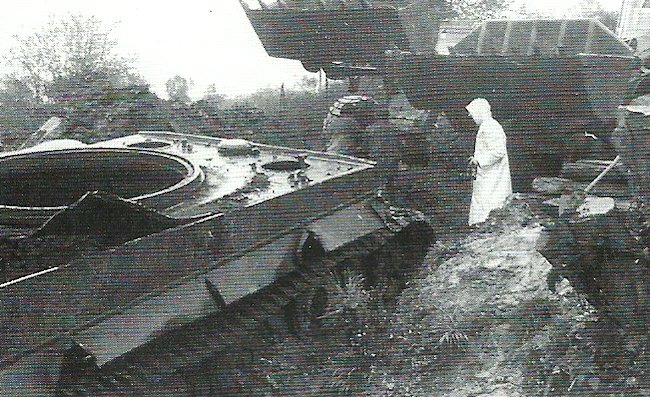
The Vimoutiers Tiger Recover photos. Two large tracked diggers were needed to tow it out of its road side position.
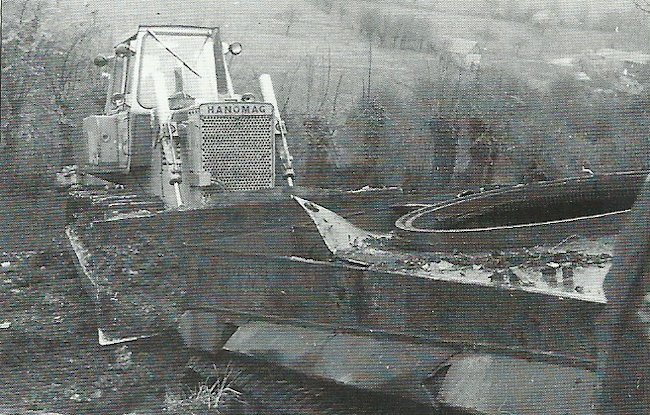
The Vimoutiers Tiger Recover photos. A third digger was required at the rear to give it a push. Notice the name on this tractor. Hanomag.
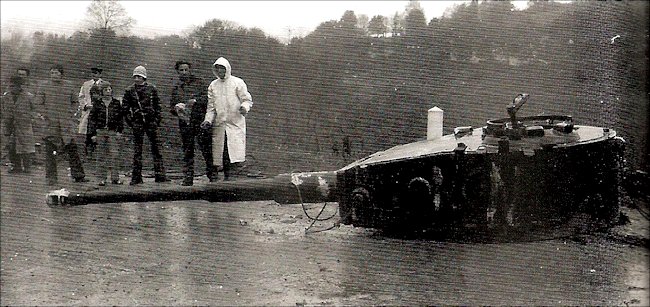
The Vimoutiers Tiger tank turret was removed first to reduce the weight of the vehicle.
D-Day 1944 books

